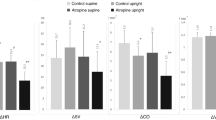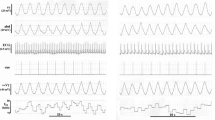Abstract
Two autonomic tests which evaluate cardiac vagal activity, the respiratory sinus arrhythmia and the newer 4-second exercise test, have been compared. From electrocardiograph tracings, respiratory sinus arrhythmia was quantified by the ratio between the longest R-R interval during expiration and the shortest one during inspiration (E/I ratio), and the 4-second exercise test by the ratio between the last R-R interval before and the shortest one during exercise (B/C ratio). In 29 healthy subjects there was a correlation (R = 0.60,p < 0.05) between the responses to the two tests. In a group of six healthy subjects the same tests were performed after autonomic blockade with intravenous atropine and/or propranolol. The heart rate rise during the 4-second exercise test was nearly abolished by atropine (mean ± SD) (B/C: control = 1.53/0.33; after atropine = 1.04/0.03), whereas RSA was diminished to a lesser extent (E/I: control = 1.59/0.24; after atropine = 1.13/0.07). β-adrenoceptor blockade did not affect the test ratios (after propranolol: B/C = 1.51/0.33 and E/I = 1.45/0.14). Successive tests during the following hour after atropine infusion showed a somewhat faster recovery of the respiratory sinus arrhythmia than the heart rate acceleration induced by the 4-second exercise test (p < 0.05). We conclude that there may be some difference in the mechanisms which contribute to the heart rate changes in these two autonomic cardiovascular tests; these remain to be clarified. The 4-second exercise test may be an alternative to the respiratory sinus arrhythmia test in the non-invasive evaluation of cardiac parasympathetic activity.
Similar content being viewed by others
References
Kleiger RE, Miller JP, Bigger JT, Jr, Moss AJ, The Multicenter Post-Infarction Research Group. Decreased heart rate variability and its association with increased mortality after acute myocardial infarction.Am J Cardiol 1987;59: 256–262.
Craddock C, Pasvol G, Bull R, Protheroe A, Hopkin J. Cardiorespiratory arrest and autonomic neuropathy in AIDS.Lancet 1987;ii: 16–18.
Ewing DJ, Campbell IW, Clarke BF. Assessment of cardiovascular effect in diabetic autonomic neuropathy and prognostic implications.Ann Intern Med 1980;92 (part 2): 308–311.
Ewing DJ, Irving JB, Kerr F, Wildsmith JAW, Clarke BF. Cardiovascular responses to sustained handgrip in normal subjects and in patients with diabetes mellitus: a test of autonomic function.Clin Sci Mol Med 1974;46: 295–306.
Wieling W, Van Brederode JFM, de Rijk LG, Borst C, Dunning AJ. Reflex control of HR in normal subjects in relation of age: a data base for cardiac vagal neuropathy.Diabetology 1982;22: 163–166.
Soulma ML, Cabaniss CD. The Valsalva manoeuver: a test of autonomic nervous system function in pregnancy.Am J Obstet Gynecol 1983;145: 274–278.
Ewing DJ, Martyn CN, Young RJ, Clarke BF. The value of cardiovascular autonomic function tests: 10 years experience in diabetes.Diabetes Care 1985;8: 491–498.
Wieling W, Borst C, Karemaker JM, Dunning AJ. Testing for autonomic neuropathy: initial heart rate response to active and passive changes of posture.Clin Physiol 1985;5 (suppl 5): 23–27.
Weise F, Muller D, Krell D, Kielstein V, Koch RD. Heart rate variability in chronic alcoholic: a follow-up study.Drug Alcohol Depend 1986;17: 365–368.
Mustonen J, Lansimies E, Uusitupan M, Talwar S, Hyodynmaa S, Karkkainen A. Testing of autonomic cardiovascular regulation—methodological considerations.Clin Physiol 1989;9: 249–257.
Genovely H, Pfeifer MA. R-R variation: the autonomic test of choice in diabetes.Diabetes Metabol Rev 1988;4: 255–271.
Sundkvist G, Almer LO, Lilja B. Respiratory influence on heart rate in diabetes mellitus.Br Med J 1979;1 (6168): 924–925.
Bergstom B, Lilja BO, Rosberg K, Sundkvist G. Autonomic nervous function tests—reference values in healthy subjects.Clin Physiol 1986;6: 523–528.
Wheeler T, Watkins PJ. Cardiac denervation in diabetes.Br Med J 1973;4: 584–586.
Katona PG, Jih F. Respiratory sinus arrhythmia: non-invasive measure of parasympathetic cardiac control.J Appl Physiol 1975;39: 801–805.
Levy MN, DeGeest H, Zieske H. Effects of respiratory center activity on the heart.Circ Res 1966;18: 67–77.
Anrep GV, Pascual W, Rossler R. Respiratory variations of the heart rate. II—The central mechanism of the respiratory arrhythmia and the inter-relation between the central and the reflex mechanisms.Proc R Soc London 1936;B119: 218–232.
Petro JK, Hollander AP, Bouman LN. Instantaneous cardiac acceleration in man induced by a voluntary muscle contraction.J Appl Physiol 1970;29: 794–798.
Araujo CGS. Fast ‘on’ and ‘off’ heart rate transients at different bicycle exercise levels.Int J Sports Med 1985;6: 68–73.
Araujo CGS, Nobrega ACL, Castro CLB. Vagal activity: effect of age, sex and physical activity pattern.Brazilian J Med Biol Res 1989;22: 909–911.
Mehelsen J, Pagh K, Nielsen JS, Sestoft L, Nielsen SL. Heart rate response to breathing: dependency upon breathing pattern.Clin Physiol 1987;7: 115–124.
Jose AD, Taylor RR. Autonomic blockade by propranolol and atropine to study intrinsic myocardial function in man.J Clin Invest 1969;48: 2019–2031.
Fragaeus L, Linnarsson D. Autonomic origin of heart rate fluctuations at the onset of muscular exercise.J Appl Physiol 1976;40: 679–682.
Bernardi L, Keller F, Sanders M, Reddy PS, Griffith B, Memo F, Pimsky MR. Respiratory sinus arrhythmia in the denervated human heart.J Appl Physiol 1989;67: 1447–1455.
Brown HJ. Atropine, scopolamine and related antimuscarinic drugs. In: Gilman AG, Rall TW, Nies AS, Taylor P, eds.Gilman and Goodman: The pharmacological basis of therapeutics. New York: Pergamon Press, 1990; 150–165.
Yamamoto Y, Hughson R. Coarse graining spectral analysis: new method for studying heart rate variability.J Appl Physiol 1991;71: 1143–1150.
Author information
Authors and Affiliations
Rights and permissions
About this article
Cite this article
Araujo, C.G.S., Nobrega, A.C.L. & Castro, C.L.B. Heart rate responses to deep breathing and 4-seconds of exercise before and after pharmacological blockade with atropine and propranolol. Clinical Autonomic Research 2, 35–40 (1992). https://doi.org/10.1007/BF01824209
Received:
Accepted:
Issue Date:
DOI: https://doi.org/10.1007/BF01824209




